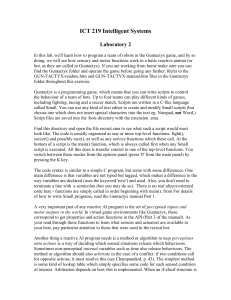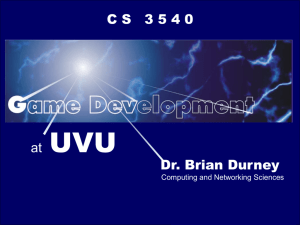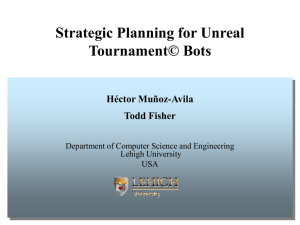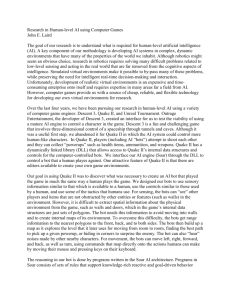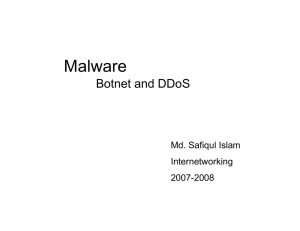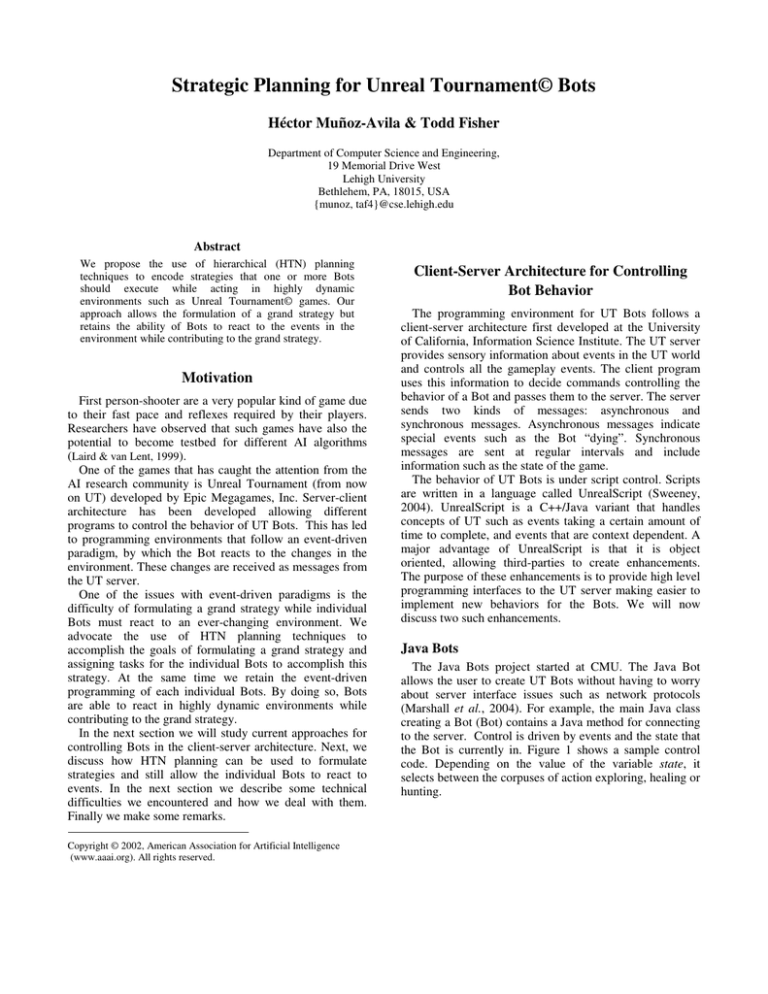
Strategic Planning for Unreal Tournament© Bots
Héctor Muñoz-Avila & Todd Fisher
Department of Computer Science and Engineering,
19 Memorial Drive West
Lehigh University
Bethlehem, PA, 18015, USA
{munoz, taf4}@cse.lehigh.edu
Abstract
We propose the use of hierarchical (HTN) planning
techniques to encode strategies that one or more Bots
should execute while acting in highly dynamic
environments such as Unreal Tournament© games. Our
approach allows the formulation of a grand strategy but
retains the ability of Bots to react to the events in the
environment while contributing to the grand strategy.
Motivation
First person-shooter are a very popular kind of game due
to their fast pace and reflexes required by their players.
Researchers have observed that such games have also the
potential to become testbed for different AI algorithms
(Laird & van Lent, 1999).
One of the games that has caught the attention from the
AI research community is Unreal Tournament (from now
on UT) developed by Epic Megagames, Inc. Server-client
architecture has been developed allowing different
programs to control the behavior of UT Bots. This has led
to programming environments that follow an event-driven
paradigm, by which the Bot reacts to the changes in the
environment. These changes are received as messages from
the UT server.
One of the issues with event-driven paradigms is the
difficulty of formulating a grand strategy while individual
Bots must react to an ever-changing environment. We
advocate the use of HTN planning techniques to
accomplish the goals of formulating a grand strategy and
assigning tasks for the individual Bots to accomplish this
strategy. At the same time we retain the event-driven
programming of each individual Bots. By doing so, Bots
are able to react in highly dynamic environments while
contributing to the grand strategy.
In the next section we will study current approaches for
controlling Bots in the client-server architecture. Next, we
discuss how HTN planning can be used to formulate
strategies and still allow the individual Bots to react to
events. In the next section we describe some technical
difficulties we encountered and how we deal with them.
Finally we make some remarks.
Copyright © 2002, American Association for Artificial Intelligence
(www.aaai.org). All rights reserved.
Client-Server Architecture for Controlling
Bot Behavior
The programming environment for UT Bots follows a
client-server architecture first developed at the University
of California, Information Science Institute. The UT server
provides sensory information about events in the UT world
and controls all the gameplay events. The client program
uses this information to decide commands controlling the
behavior of a Bot and passes them to the server. The server
sends two kinds of messages: asynchronous and
synchronous messages. Asynchronous messages indicate
special events such as the Bot “dying”. Synchronous
messages are sent at regular intervals and include
information such as the state of the game.
The behavior of UT Bots is under script control. Scripts
are written in a language called UnrealScript (Sweeney,
2004). UnrealScript is a C++/Java variant that handles
concepts of UT such as events taking a certain amount of
time to complete, and events that are context dependent. A
major advantage of UnrealScript is that it is object
oriented, allowing third-parties to create enhancements.
The purpose of these enhancements is to provide high level
programming interfaces to the UT server making easier to
implement new behaviors for the Bots. We will now
discuss two such enhancements.
Java Bots
The Java Bots project started at CMU. The Java Bot
allows the user to create UT Bots without having to worry
about server interface issues such as network protocols
(Marshall et al., 2004). For example, the main Java class
creating a Bot (Bot) contains a Java method for connecting
to the server. Control is driven by events and the state that
the Bot is currently in. Figure 1 shows a sample control
code. Depending on the value of the variable state, it
selects between the corpuses of action exploring, healing or
hunting.
switch( state ) {
default:
case EXPLORING:
explore();
break;
case HEALING:
heal();
break;
case HUNTING:
hunt();
break;
}
Figure 1: Excerpt of the code from a JavaBot
Event handlers are used to detect relevant events that may
require interrupting the current action been executed to
select a new one. For example, while performing the
exploring action, the Bot may interrupt the explore action
and start a hunting action if it detects an enemy in the
surrounding area.
Soar Bots
The Soar Bot project was developed at the University of
Michigan. Soar Bot is based on the Soar Architecture
(Laird et al., 1987). Soar uses operators, which define basic
deliberative acts. Operators consist of preconditions and
effects. This is the standard representation of operators in
AI Planning (Fikes & Nilsson, 1972). Preconditions indicate
the conditions that must be valid in the state of the world to
apply the operator and the effects indicate the changes in
the state of the world when the operator is applied. For
example, an operator may have as condition that an enemy
is within visual range of the Bot and as effect to start
hunting at the enemy. This hunt effect may be the condition
for another operator. This is the same kind of behavior that
can be encoded by event handlers and conditional
branching such as the one represented in Figure 1.
However, operators allow a more declarative representation
of the behavior of the Bots.
Soar also defines rules, which select and apply operators.
They can compare and terminate the execution of
operators. Soar uses a mechanism to select the more
suitable rule for a particular situation, which in turn will
determine which operator is selected. For example, one rule
may select the operator for hunting an enemy in the event
of sighting it. Another rule may select to run from the
enemy also in the event of sighting the enemy. Soar will
choose the rule (and as a result the operator) that is more
suitable according to their utility in the current situation
(Laird & Duchim, 2000). Since rules are evaluated
continuously, Soar can react quickly to changing situations
by interrupting the execution of the current operator and
selecting a new one. Soar Bot uses a Tcl wrapper to deal
with communication issues with the server. Soar Bots work
only for one Bot (i.e., it can’t coordinate multiple Bots).
Hierarchical (HTN) Representations of Bot
Strategies
Several variants have been proposed for hierarchical
planning (e.g., (Wallace; 2003)). The particular variant we
follow in this paper is the one described in (Nau et al.,
1999). This variant has been used successfully in several
real-world applications including the Bridge Baron game
(Smith et al., 1998). We will show how this variant can be
used to encode high-level strategies while coordinating
individual UT bots.
HTNs (for: Hierarchical Task Networks) is a formalism
for representing hierarchical plans. HTNs refine high-level
tasks into simpler tasks. In the context of UT Bots, highlevel tasks indicate complex goals such as Domination(X),
where X is the list of objects of type location that must be
controlled. In domination games, when team members steps
into one of the locations in X, the team gets a point for
every five seconds it remains under the control of the team.
The game is won by whoever team gets a certain amount of
points first.
Low-level tasks range from intermediate goals such as
capturing a certain location to concrete actions such as
attacking an enemy in the surrounding area. Tasks
representing concrete actions are called primitive tasks
since they cannot be decomposed into other subtasks.
Compound tasks are tasks that can be further decomposed
into simpler subtasks.
Formally, a hierarchical Task Network is a set of tasks
and their ordering relations, denoted as N=({t1,…,tm},<)
(m≥0), where < is a binary relation expressing temporal
constraints between tasks. One of the most important
properties of HTNs, and of particular interest for
representing UT Bots strategies, is that HTNs are strictly
more expressive than operator representations (Erol et al.,
1994), which use preconditions and effects.
Method
Head: Domination(X)
Preconditions:
1. numberPlayersTeam(Nteam),
2. numberLocations(X,N),
3. Nteam > N/2 + 2
4. SelectLocsGeographTogether(X,P,N/2+1)
5. Divide3Groups(N/2+1,T1,T2,T3),
6. RemainingLocations(RP,X,P)
Subtasks:
1. CoverLocations(T1,P)
2. PatrolLocations (T2,P)
3. HarrassLocations(T3,RP)
Orderings:
none
Figure 2: Example of a method for decomposing the
task domination
The knowledge artifacts for representing under which
conditions a compound task can be decomposed are called
methods. Methods encode strategies for accomplishing
compound tasks. A method is an expression of the form
M=(h,P,ST,<), where h (the method's head) is a compound
task, P is a set of preconditions, and ST is the set of M's
(children) subtasks. Figure 2 shows an example of a
method for UT Bots. The task decomposed by method is
Domination(X). This method states a strategy that divides
the team into three groups (T1, T2, T3). Group T1 will cover
half of the locations plus one (P denotes these locations).
Each location in P is covered by one member of T1
(Subtask 1). Group T2 will patrol throughout the points in P
(Subtask 2). Group T3 will harass the members of the
opposing team in the remaining locations (Subtask 3).
A method is applicable to decompose a task if the
preconditions are valid in the current state of the world.
The method in Figure 2 requires that the team to be as large
as at least half of the locations plus two (Preconditions 13). The 4th precondition sets P to be half of the locations
plus one that are geographically together. The 5th
precondition divides the team in 3 groups, T1, T2, and T3.
Group T1 will have N/2 + 1 members. The remaining
elements of the team are distributed evenly among T2, and
T3. The last precondition sets RP to be the locations in X
that are not in P.
Figure 3 shows an example map. The three white squares
represent the domination locations, X. If there are 4 Bots in
the team, the method shown in Figure 2 becomes
applicable. In this situation, P could consist either of the
middle and the upper right locations or the middle and the
lower left locations. T1 consists of 2 Bots, each of which
will be assigned to one location in P. T2 consists of a single
Bot, which will be in charge of patrolling the 2 locations in
P. T3 consists of the remaining Bot and will harass any
enemy Bot in the location not in P.
Figure 3: A map with 3 domination locations
represented by the white boxes
An important characteristic of HTN planning is that
method decomposition does not change the state of the
world. The compound tasks represent high level goals and
the methods capture strategies to achieve (decompose)
them. The actual changes in the world are done when
accomplishing primitive tasks. These tasks are
accomplished by operators, which differ from the standard
operators in that they have no preconditions, only effects.
The reason is that the actual conditions are evaluated when
selecting the adequate strategy (in the method selection).
Once the primitive tasks are reached, the strategy has been
selected and it is executed by the Bots performing concrete
actions (i.e., the operator’s effects).
Formally an operator is an expression of the form
O=(h,effects), where h (the operator's head) is a primitive
task, and effects are indicate how the world changes. Figure
4 shows an example of an operator achieving the primitive
task CoverLocation(B,L). In this task an specific Bot, B, is
assigned to cover an specific location L. The effects of this
operator are to move B to location L and defend it.
Operator
Head: CoverLocation(B,L)
Effects:
Move(B,L)
Defend(B,L)
Figure 4: Example of an operator commanding a Bot B
to cover location L
Built-In Preconditions and Effects
Initially, our plan was to represent the methods and
operators using a declarative syntax such as the one
exemplified in Figures 2 and 4. We found quickly two
problems with this approach. First, preconditions such as
the ones described in Figure 2 can be difficult to express.
Take for example the 4th precondition, which selects half
plus one domination locations in X that are geographically
together. Expressing such a condition in a declarative
language involves making complex expressions.
Furthermore, even if we could develop a complete
declarative language, most likely processing such
expressions would take prohibitive long time in a very fastpaced environment such as UT. Second, effects such as
Move(B,L) also represents complex executions. Any
definition of Move will have to consider a path to get there
and contingencies that may occur (e.g., finding an enemy
along the way).
Our solution for both problems was to use Java Bot
methods to define a method’s preconditions and operator’s
effects. This allows for a rapid evaluation of preconditions
and executing effects (commanding Bots to execute
actions). These Java Bot functions are built-in functions
that preserve the principles of strategic planning resulting
from the HTN task decomposition process. Figure 5 shows
part of the declaration of the method presented in Figure 2.
It declares the method’s head and all the parameters. The
preconditions are evaluated in the build-in function
evalCondHalfPlusOne.
One of the subtasks,
CoverLocations, is also shown with its associated
parameters.
<ooba_method task="Domination">
<ooba_listparameter>
<ooba_parameter id =”X”>
<ooba_parameter id =”T1”>
<ooba_parameter id =”T2”>
<ooba_parameter id =”T3”>
<ooba_parameter id =”P”>
<ooba_parameter id =”RP”>
</ooba_listparameter>
<ooba_routine def=”evalCondHalfPlusOne”/>
<ooba_listTasks>
<ooba_task id="CoverLocations" order="0">
<ooba_listparameter>
<ooba_parameter id =”T1”>
<ooba_parameter id =”P”>
</ooba_listparameter>
</ooba_task>
…
</ooba_listTasks>
</ooba_method>
Figure 5: representation of the Method of Figure 2 in
the XML language description
Operators are defined similarly, with their effect being
the call to a Java Bot routine that uses the standard eventdriven paradigm to control the behavior of the Bot. An
important restriction is that each operator affects a single
Bot. Thus, the coordination of the Bots is reflected in the
hierarchy and not in the specific actions they undertake.
Strategy Change versus Strategy Modification
Once the strategy is selected, it is pursued until the
strategy is changed (i.e., a new strategy is selected). While
the Bots react to the changes in the environment, the
strategy is not modified. The main advantage is that this
scheme ensures that a unified strategy will be pursued. The
main drawback is that conditions may change so
dramatically the current strategy may not be adequate
anymore. We will extend our approach to continuously
evaluate applicability conditions of the high-level
strategies. When the applicability of the current strategy
falls below a pre-defined threshold, a new strategy is
selected for execution.
We will also explore replanning techniques as an
alternative to selecting a new strategy. In replanning, parts
of the current strategy are modified to account for changes
in the current environment (Petrie, 1991). The main
advantage over selecting a new strategy is that, by
modifying the current strategy, some tasks may not need to
change at all, and Bots performing these tasks can continue
performing them. In contrast, a change in strategy will
result in a change of the task that every Bot is performing.
Final Remarks
One of the issues with event-driven paradigms typically
used to control the behavior of the Bots is the difficulty of
coping with seemingly contradictory goals. On the one
hand the Bot needs to react quickly in a highly dynamic
environment. On the other hand the Bot must contribute to
the grand strategy to win the game. We advocate the use of
HTN planning techniques to accomplish these goals. A
grand strategy is laid out and event-driven programming
allows the Bots to react in highly dynamic environments
while contributing to the grand task.
References
Erol, K., Nau, D., & Hendler, J. HTN planning: Complexity and
expressivity. In: Proceedings of the Twelfth National Conference
on Artificial Intelligence (pp. 123-1128). Seattle, WA: AAAI
Press, 1994.
Fikes, R., and Nilsson, N. J. Learning and executing generalized
roBots. Artificial Intelligence 3(4):251--288. 1972.
Laird, J. E., Duchim J.C. Creating Human-like Synthetic
Characters with Multiple Skill Levels: A Case Study using the
Soar QuakeBot.. AAAI 2000 Fall Symposium Series: Simulating
Human Agents, AAAI Press. November 2000.
Laird, J. E., Newell, A., and Rosenbloom, P. S. Soar: An
architecture for general intelligence. Artificial. Intelligence,
33(3), 1-64. 1987
Laird, J. E. and van Lent, Michael, Developing an Artificial
Intelligence Engine, Proceedings of the Game Developers
Conference, San Jose, CA, pp. 577-588. March 16-18, 1999
Marshall, A., Rozich, R., Sims, J., & Vaglia, J. Unreal
Tournament Java Bot. http://sourceforge.net/projects/utBot/ Last
viewed: March 2004
Nau, D. S., Cao, Y., Lotem, A., and Muñoz-Avila, H. SHOP:
Simple hierarchical ordered planner. Proceedings of the
International Joint Conference on Artificial Intelligence (IJCAI),
pp. 968-973. Morgan Kaufmann Publishers, July 31-August 6
1999.
Petrie, C. (1991). Planning and Replanning with Reason
Maintenance. PhD thesis, University of Texas at Austin,
Computer Science Dept.
Smith, S. J. J, Nau, D. S. and Throop, T. Success in spades:
Using AI planning techniques to win the world championship of
computer bridge. AAAI/IAAI Proceedings, pp. 1079-1086, 1998.
Sweeney,
T.
UnrealScript
Language
Reference.
http://unreal.epicgames.com/UnrealScript.htm
Last
viewed:
March 2004.

